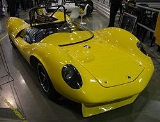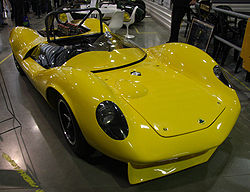
Lotus 30
Encyclopedia
The Lotus 30 was a racing automobile
, Colin Chapman
's first and only attempt at a Group Seven / Can Am racing machine, and was first built in 1964, designed by Colin Chapman
and Martin Wade. It was most notable for its curvaceous fibreglass body work and "pickle fork" backbone chassis design first seen in the front engine Lotus Elan. On the 30 the layout was reversed and placed the engine behind the driver. Lotus engineer Len Terry was asked by Chapman to comment on the draft concept and considered it to be so flawed he refused to have anything to do with it. The Lotus 30 was powered by a 4.7 litre (289 c.i.) Ford
V8 engine, the same type as used in the Ford GT40
, mated to a 5 speed ZF syncromesh gearbox. It used 13 inch wheels and solid disc brakes on each wheel. The Lotus 30 was regarded as unsuccessful and / or dangerous but when everything was working and nothing broke the car was incredibly fast.
 The inherent flaws of the engineering became evident as horse power requirements and tire technology of the period evolved and pushed the original design past its intended limits. The problems were mainly related to the torsional rigidity of the backbone chassis and materials available at the time, all of which resulted in chassis and suspension failures.
The inherent flaws of the engineering became evident as horse power requirements and tire technology of the period evolved and pushed the original design past its intended limits. The problems were mainly related to the torsional rigidity of the backbone chassis and materials available at the time, all of which resulted in chassis and suspension failures.
Jim Clark
laboured long with the car, and managed to prize some promising results with it before it was replaced with the Lotus 40. Equipped with 15in wheels and vented disc brakes as well as a larger engine, the 40 was just as recalcitrant as the 30. The most telling comment about these Lotus race cars was made by the American driver Richie Ginther
. When asked what he thought of the new Lotus 40, Ginther, a lugubrious Californian, said, "Same as the 30 but with ten more mistakes".
The effort was not a total loss as this chassis type proved to be perfectly acceptable for the lower powered Lotus Europa
and was with development used on the Esprit series cars.
Auto racing
Auto racing is a motorsport involving the racing of cars for competition. It is one of the world's most watched televised sports.-The beginning of racing:...
, Colin Chapman
Colin Chapman
Anthony Colin Bruce Chapman CBE was an influential British designer, inventor, and builder in the automotive industry, and founder of Lotus Cars....
's first and only attempt at a Group Seven / Can Am racing machine, and was first built in 1964, designed by Colin Chapman
Colin Chapman
Anthony Colin Bruce Chapman CBE was an influential British designer, inventor, and builder in the automotive industry, and founder of Lotus Cars....
and Martin Wade. It was most notable for its curvaceous fibreglass body work and "pickle fork" backbone chassis design first seen in the front engine Lotus Elan. On the 30 the layout was reversed and placed the engine behind the driver. Lotus engineer Len Terry was asked by Chapman to comment on the draft concept and considered it to be so flawed he refused to have anything to do with it. The Lotus 30 was powered by a 4.7 litre (289 c.i.) Ford
Ford Motor Company
Ford Motor Company is an American multinational automaker based in Dearborn, Michigan, a suburb of Detroit. The automaker was founded by Henry Ford and incorporated on June 16, 1903. In addition to the Ford and Lincoln brands, Ford also owns a small stake in Mazda in Japan and Aston Martin in the UK...
V8 engine, the same type as used in the Ford GT40
Ford GT40
The Ford GT40 was a high performance sports car and winner of the 24 hours of Le Mans four times in a row, from 1966 to 1969...
, mated to a 5 speed ZF syncromesh gearbox. It used 13 inch wheels and solid disc brakes on each wheel. The Lotus 30 was regarded as unsuccessful and / or dangerous but when everything was working and nothing broke the car was incredibly fast.

Jim Clark
Jim Clark
James "Jim" Clark, Jr OBE was a British Formula One racing driver from Scotland, who won two World Championships, in 1963 and 1965....
laboured long with the car, and managed to prize some promising results with it before it was replaced with the Lotus 40. Equipped with 15in wheels and vented disc brakes as well as a larger engine, the 40 was just as recalcitrant as the 30. The most telling comment about these Lotus race cars was made by the American driver Richie Ginther
Richie Ginther
Paul Richard "Richie" Ginther was a racecar driver from the United States. During a varied career, the 1965 Mexican Grand Prix saw Ginther take Honda's first Grand Prix victory, a victory which would also prove to be Ginther's only win in Formula One...
. When asked what he thought of the new Lotus 40, Ginther, a lugubrious Californian, said, "Same as the 30 but with ten more mistakes".
The effort was not a total loss as this chassis type proved to be perfectly acceptable for the lower powered Lotus Europa
Lotus Europa
The Lotus Europa was a two door mid-engined GT coupé built by Lotus Cars from 1966 to 1975. In 2006 Lotus began production of a totally new, Lotus Elise-derived design, a mid-engined GT coupé named Europa S....
and was with development used on the Esprit series cars.

